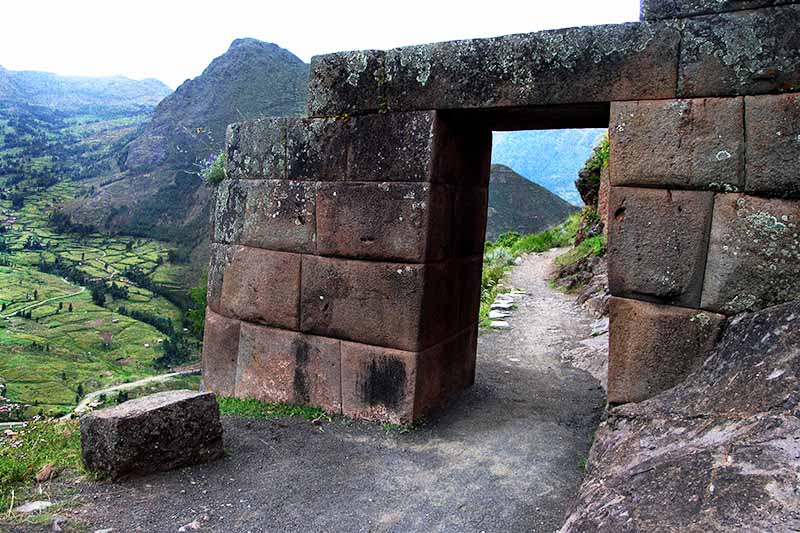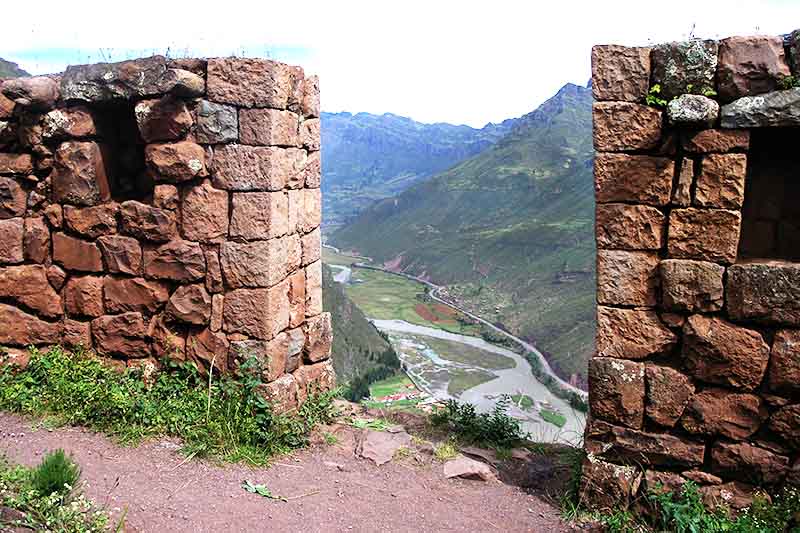Hike through the ancient Inca city of Pisac
One of the most beautiful archaeological jewels of the Sacred Valley of the Incas is undoubtedly the ancient Inca city of Pisac, a must for anyone visiting the valley. Located on the mountainside above the town of Pisac, it is unknown to most visitors and despite being as impressive as Machu Picchu itself, it does not receive even a tenth of the number of visitors it receives every day.
- What is the ancient Inca city of Pisac like?
- How to get from the town of Pisac to the ancient Inca town?
- The trail
- Continue along the mountain trail
- Temple of the Sun Complex (ceremonial center)
- Downhill
- Degree of difficulty and travel time

Entrance gate and beginning of the hike through the ancient Inca city of Pisac
The main part of the ancient Inca city of Pisac is located 25 to 30 minutes from the town of Pisac. If you are adventurous and want to experience something truly amazing and unique, which 90% of visitors to Cusco overlook, be sure to include the hike through the ancient Inca city of Pisac. It can be the highlight of your experience getting to know the culture of the Incas.
What is the ancient Inca city of Pisac like?
The ancient Inca settlement of Pisac is located at the eastern end of the Sacred Valley of the Incas, one hour from Cusco. It is located at the bottom of the valley, on a mountain behind the present town of Pisac, existing since colonial times. It is one of the best Inca archaeological sites in Peru.
Some historians claim that the name Pisac derives from the word “pisaca” meaning partridge, and it is possible that the vast agricultural terraces on the mountain slopes represent the wings of the partridge. Near the main structures, at the top, you will find the largest known Inca cemetery in existence, which in turn, is the largest ancient cemetery in South America.
How to get from the town of Pisac to the ancient Inca town?
You can take the ascent from the town of Pisac, by a hidden access road that leads to the back and then to the mountainside where the Inca village is located or you can call a cab, it will take you by the back to the ruins. You can board them from the main road, they charge between 30 and 35 soles (US$ 10 – 12). It will take about 15 to 20 minutes to get there.
To enter the archaeological complex of Pisac you will need the Cusco Tourist Ticket; you can purchase the general ticket, which includes 16 of the most impressive sites in Cusco, or purchase only the “Partial Tourist Ticket Circuit 3” (Archaeological Sites of the Sacred Valley of the Incas). In case of using a cab to go up to the archaeological site of Pisac, be sure to agree on the price before boarding.

Remains of agricultural terraces located in Pisac
The trail
Once at the site, you will have to make your way through the tourist buses that are parked – stuck – in a small parking lot at the beginning of the archaeological park. You will arrive at a set of wide agricultural terraces that descend the mountainside. Take the road to the right, you will see an Inca urban settlement known as Q’alla Q’asa situated above you on the mountainside; you will also see ceremonial springs fed by an intricate network of stone canals, and the Inca cemetery – the largest ancient burial ground in South America – on an adjacent hillside.
Continue along the mountain trail
Continue along the path that hugs the mountainside, after a few hundred meters you will enter through a beautiful lithic gate, this marks the entrance to the main temple complex, you will have stunning views of the left side, the undulating path continues up the mountainside before reaching a narrow tunnel. Coming out of the small tunnel you will get the first image of a small residence and agricultural area on the lower left, often referred to as Pisaca or Q’allaqasa; from here you will continue for 10 minutes to the main temple of the ancient Inca city of Pisac.
Temple of the Sun Complex (ceremonial center)
The constructions of the ancient village of Pisac, are among the few that can prepare you for what you will see in Machu Picchu, or those that are at your height, if you have already seen the wonder. Situated on a small ledge with beautiful panoramic views from both sides, the complex is composed of a dozen buildings built with pink granite stones exquisitely “carved”, although molded would be the more accurate term.
The Temple of the Sun with an Intihuatana (sundial) as its centerpiece, has a curved back wall and a straight front wall, similar to a letter D; the temple is perfectly aligned to the sun and marks with incredible precision the summer and winter solstices. The narrow water channels, the exquisite work in its stones, the altars and wells found reflect its spiritual importance and sacred character.
Downhill
From the incredible complex of the Temple of the Sun you can continue descending to a point where you can see how the three valleys surrounding Pisac converge. An optional trail continues – uphill – to a rocky outcrop where other buildings and watchtowers are attached to the mountainside. If you don’t feel like climbing, a trail just beyond the complex leaves in the direction of the urban sector. The many terraced levels that literally drop off the mountainside will give you the opportunity to take in unique views.
This is one of the best times to take some time and rest. The trail will continue for another 20 minutes before connecting with a wide path, which descends gently to the village of Pisac.

Beautiful views that you will have while hiking through the Inca city of Pisac
Degree of difficulty and travel time
This hike is recommended for almost anyone, as long as you have the desire to see some of the most amazing constructions of what was once the empire of the Incas. Most of the trail will be downhill, except for the first 20 minutes, which undulates up and down. Most of the trail goes along the edge of the mountain so we do not recommend hiking with small children, but if you do, take them by the hand and keep an eye on them.
It will take between 1 ½ and 2 hours to complete the trek from the top of the mountain to the Pisac market in the town square. However, as you can imagine, the time may vary depending on the pace at which you walk, how long you stop at each of the places you want, and how much time you take to rest.
- Take a small bottle of water with you, it is possible to find vendors before entering the site, but you cannot count on them being there.
- We recommend you to wear hiking shoes, it is the most appropriate footwear for this hike.
- Be sure to bring sun protection! The hike is quite exposed, and you will end up with sunburn if you don’t protect yourself.
- Walking sticks are still allowed in Pisac, take 1 or 2 “if you need them”. Remember that you will not be able to use them in Machu Picchu.
- Although the road is well marked, they may have forgotten to mark some places; if you are not sure which way to go, remember that the mountain should remain almost at all times on your right, this does not get lost.
- The rainy season runs from November to March, so if you visit during this time be prepared to get wet. Rain usually falls in the afternoons, so we recommend doing the hike in the morning. However, it can rain at any time of the year.
- If you do not buy the General Cusco Tourist Ticket, we recommend you to buy at least the Partial Ticket – Circuit 3 (Archaeological Sites of the Sacred Valley); remember that buying the entrance tickets for each of the sites separately can be much more expensive.
- The Pisac Archaeological Park is open every day of the year from 7 am to 6 pm.
Advice from people who have been there
 By: Rigel G.
By: Rigel G.“Beautiful place“
“One of the most beautiful places in Peru within the Sacred Valley of the Incas. The views of the valley from this place are impressive, but the buildings are even more so. Not to be missed!“
By Ticket Machu Picchu – Last updated, July 10, 2024